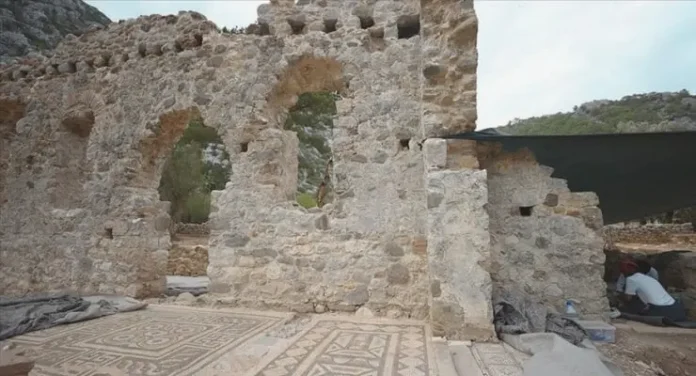Archaeologists in Olympos Ancient City, located in Turkey’s Antalya province, have uncovered a remarkable 200-square-meter Byzantine bathhouse during ongoing excavations. The discovery sheds new light on the social and religious life of the city’s elite, particularly during the Late Antiquity period.
A Key City of the Lycian League
Olympos, situated on the eastern edge of the Lycian civilization, was one of the six most important cities of the Lycian League, holding three votes in its federal assembly. Today, excavations in the city continue year-round, gradually revealing layers of history from the Hellenistic, Roman, and Byzantine periods.
Since 2006, archaeological teams have unearthed temples, streets, and public buildings. This year, under the leadership of Assoc. Prof. Gökçen Kurtuluş Öztaşkın from Pamukkale University, excavators made one of the site’s most significant finds: a large bathhouse dating back to the 5th–6th centuries AD.
A Unique Bathhouse Linked to a Bishop
According to Öztaşkın, the architectural features indicate that the bathhouse once belonged to a Byzantine bishop. Unlike small private baths attached to houses, this bath is unusually large, covering nearly 200 square meters.
“We discovered a spacious bath complex with a fully preserved heating system, including furnaces and wall heating structures. Such well-preserved remains from Late Antiquity are extremely rare,” Öztaşkın noted.
During the Byzantine era, bishops held not only spiritual authority but also acted as administrators of the city, controlling resources and guiding large communities. The scale and quality of the Olympos bathhouse underline the bishop’s dual role as both religious leader and civic governor.
More Than Just a Private Space
While the bathhouse was part of the bishop’s residence, evidence shows it was not exclusively for private use. One entrance opened to the bishop’s residence, while another opened directly onto the city’s main street.
Öztaşkın explained that on certain days of the week, the bishop allowed local citizens to use the bath free of charge:
“The bathhouse served both hygiene and health purposes. The bishop offered it as a public service, reflecting his responsibility not only as a church leader but also as a provider for the people.”
This dual function emphasizes the social and charitable role of the clergy in Byzantine society, where religious figures often acted as intermediaries between the ruling elite and the general population.
Rare Example of Late Antique Architecture
The discovery is particularly valuable because baths of this size, attached to bishop’s residences, are seldom found in Late Antiquity archaeological contexts. The structure preserves:
- A complete hypocaust heating system (underground furnaces),
- Wall-heating channels that distributed warm air,
- Fragments of wall cladding and decorative elements.
Such architectural details offer scholars a rare glimpse into Byzantine engineering and daily life, combining both luxury and public service.
Importance for Olympos and the Lycian Region
Olympos was already known as a wealthy and powerful city in antiquity, and this discovery further underscores its role as a religious and cultural hub in the Byzantine period. The bathhouse also illustrates how elite figures like bishops balanced private privilege with communal duty.
Experts believe the find will attract international attention and bring new perspectives to the study of urban life in Byzantine Anatolia.

